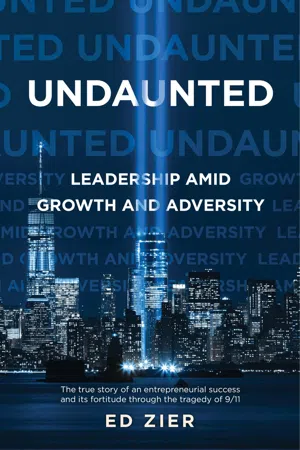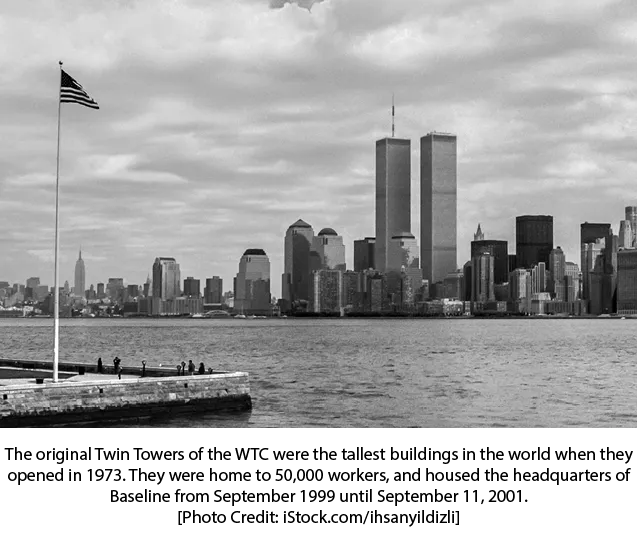![]()
CHAPTER 1
THE INFAMOUS MORNING
THE ENGINEER SKILLFULLY navigated the switches as we pulled into Hoboken’s large train station. My body swayed left or right depending upon the switch we encountered. It was 8:45 am on Tuesday, September 11, 2001. I had made this journey more than three thousand times since beginning my career. The trip often felt robotic. This particular commute was no different. It was yet another uneventful arrival into the bustling terminal that sat on the western side of the Hudson River. Once in Hoboken, commuters from all over New Jersey would then scramble to find a seat aboard trains, buses, and ferries that would escort them into New York City. While my arrival into Hoboken was uneventful, the remainder of this day would prove to be quite different.
Sunrise had bestowed a beautiful day upon the New York area. A few wispy clouds dotted the sky, and a slight breeze added to what was a near perfect late summer day. The sunshine and 70-degree weather likely tempted even the most devout workers to play hookey. However, it was post Labor Day which unofficially meant that it was time to get back to work. The crowded streets and busy offices of the Wall Street area confirmed that notion. In retrospect, anyone who wished to harm the multitudes would also have known that New Yorkers were back at their desks.
As my train from the New Jersey hamlet of Radburn came to a stop, I found myself fixated on my business trip to San Francisco scheduled for later in the day. Prior to my afternoon flight, I planned to visit my office at the World Trade Center (aka The Twin Towers) in lower Manhattan. Eight forty-five am was not my normal arrival time into Hoboken: because I was going to have a late night on the west coast and didn’t have any scheduled meetings in New York that morning, I had purposely delayed my morning departure from home.
I grabbed my briefcase and garment bag and proceeded to the PATH trains, where I walked through the labyrinth of century-old, musty smelling hallways and then down the stairs and through the turnstiles. I planted myself in a seat aboard the PATH train that would take me under the Hudson River and directly beneath the Twin Towers. In contrast to Hoboken, there was a very modern and clean PATH station right under the World Trade Center (WTC). The ride from Hoboken would last about twelve minutes. However, something wasn’t right that morning. An announcement proclaimed a troubling situation.
Your attention please. Your attention please. Service to and from the World Trade Center is suspended due to a police action at the World Trade Center. You are advised to take PATH to 33rd Street in midtown Manhattan, and then take city subways downtown.
Such were the words emanating from the loudspeaker aboard my WTC-bound PATH train at about 8:50 am. I had often heard similar words reflecting a disruption in service, but the “police action” comment was a new twist. My initial internal reaction was What kind of police action would shut down the rail service? I quickly thought about the disruptive gangs I had occasionally witnessed over the years in the New York subways. Petty theft, loud rants, and even physical altercations were my recollections. But the unfolding truth that morning was beyond my comprehension.
Those redirecting words squawking through the loudspeakers caught me off guard and were frustrating to this commuter set in his standard ways. It was a rare occasion to have PATH trains shut down completely. Delays, on the other hand, were commonplace, but not a wholesale suspension of a train line that required me to make alternate plans. Since I was carrying travel bags, I wasn’t in much of a mood for undoing what I had just accomplished—getting a seat (which was another rare occurrence). But another plan was necessary. As I saw it, I had two choices. The first would be to head across the platform and grab the 33rd Street PATH train to midtown Manhattan, as instructed. The other option was to head back upstairs and catch the NY Waterway Ferry, which would get me fairly close to the World Trade Center. I opted for the ferry. It was a tad more expensive but much faster and far more relaxing than traveling underground all the way up to 33rd Street, and then fighting for a strap to hold onto aboard a NYC Subway heading downtown. That circuitous route via underground trains could take forty-five minutes or more to make the complete trip to lower Manhattan. No thanks! I uttered to myself. Besides, it was a beautiful day to sit atop the ferry as it would make its way across the river with a grand view of the entire New York skyline.
Between 1973 and 2001, the twin towers of the World Trade Center dominated New York’s skyline reaching over 1,350 feet high, and eclipsing the Empire State Building as New York City’s tallest structure. In fact, when it was built, the WTC was the tallest man-made structure in the world. The World Trade Center was, and still is, owned by the Port Authority of New York and New Jersey. It is a governmental agency that oversees the flow of individuals, goods, and services throughout the area of New York harbor that borders the two states. It oversees all three New York area airports, the local seaports, the PATH train system, the Port Authority Bus Terminal in Manhattan, as well as the tunnels and bridges between the two states.
Because I made the decision to jump on the ferry, I grabbed my heavy bags and went back through the turnstiles and up the stairs. I still recall begrudging the darn $1.50 I was forfeiting by abandoning the PATH trains. At the top of the stairs I spotted a long line forming for ferry tickets. Apparently, my reassessment of options wasn’t lost on a hundred other commuters who had already lined up to buy their tickets. Luckily, I had a ticket in my wallet from a previous purchase and was thrilled I didn’t have to get on that line. But above ground, something else was different. The people in the ticket line were spellbound as they all looked to the east. From my particular vantage point I couldn’t yet see what they were staring at. I was still in a good frame of mind as I kept my eye on all the unfortunate folks lined up to purchase a ticket.
When I came to an opening between the train and ferry terminals, I immediately saw what they were so keenly watching: the North Tower of the World Trade Center (One World Trade) was on fire. The flames were near the top of the building. The smoke plume was not overly intense—yet. It looked like a scene from the movie Towering Inferno, and I thought that maybe a small plane had hit the building. Maybe a Cessna. The Empire State Building had once suffered such a fate back in 1945. But then again, that was during a bout of thick fog.1 The sky on the morning of September 11th, however, was breathtakingly beautiful.
I thought, How could a plane hit the building with such good visibility?
It didn’t appear plausible. However, no one in the immediate vicinity knew any differently. A quick survey of witnesses revealed the sense that a small plane had indeed hit the building. As the crow flies, the train terminal in Hoboken is almost two miles from the World Trade Center site. It’s conceivable that a larger plane would appear small. I wondered if there had been any deaths. Oh no! was my gut reaction. However, I concluded with certainty that the fire would be put out quickly. I remained optimistic, especially because I was headed for the “other” tower of the World Trade Center (the South Tower). I worked there as the chief operating officer of a financial software and information company called Baseline. My office sat on the 77th floor of Two World Trade Center facing south. The view of the harbor and Lady Liberty from that perch was stunning.
Since my destination was the other building, I quickly designed a plan by which I could arrive in Manhattan via ferry and navigate around the developing chaos. My office building was clearly safe and intact. But, as I got closer and closer to the pier, a disrupting thought occurred to me:
It’s going to be a mess in there. The New York police and fire departments never skimp on emergency responsiveness. Blocks and blocks will be cordoned off. I’m only going to the office to do light work and catch up on emails. I don’t really have to go in there! I’m not going to chance it. I’ll jump back on a northbound NJ Transit train and go home, and then take a car service to the airport this afternoon.
Before I left Hoboken, I decided to call my office to see what my colleagues knew. Certainly, my team would know something. I was very curious, but not yet terrified. I entered the old stately Hoboken Terminal building. Built in 1907 by the Lackawanna Railroad, it is a wonderful tribute to pre-war (WWI) architecture. Its magnificence had just recently been restored in a 1997–99 renovation project. Embellished with Victorian grace and moldings, and adorned in copper that had turned green through the years, the terminal was something to behold. Along its internal southern wall was a bank of pay telephones. Remember those? They were technologically sound that day, given that cellular networks had been severely curtailed by extremely heavy demands on their bandwidth. After an unsuccessful attempt with my cell phone, I grabbed one of the available pay phones.
I first placed calls to Bob Levine and Nick Webb. Bob was our chief financial officer, who had his office on the 78th floor, while Nick was my head of sales, who sat on 77. Both their offices were in or near the southeast corner of their respective floors. Baseline occupied the entire 77th floor and a portion of 78. Neither man answered his phone. I left messages—but not frantic ones, as I knew their building was safe. I wanted to establish what had happened and how chaotic it actually was on the streets below. Their horrendous day had just begun, and unbeknownst to me, their harrowing experiences were well underway.
I then proceeded to call my wife. I thought, Maybe she might know something, but I should certainly tell her I’m coming home instead of trying to enter the city. But, again, unbeknownst to me was the fact that a second plane was hitting my building as I was dialing her. She answered the home phone and literally started screaming the moment she heard my voice.
“Oh my God! Where are you?”
She had just watched the second plane, on live television, tilt its wings and fly directly into my building from the 78th to the 84th floor—on the same south side of the structure as my office. From her viewpoint, it must have hit my off...

